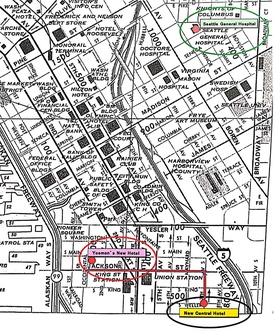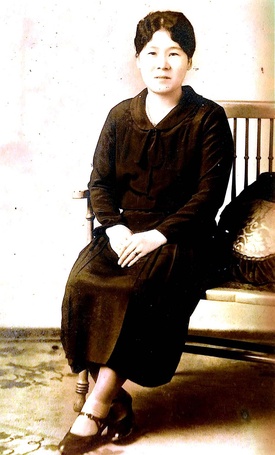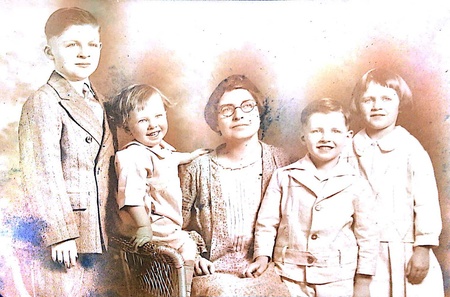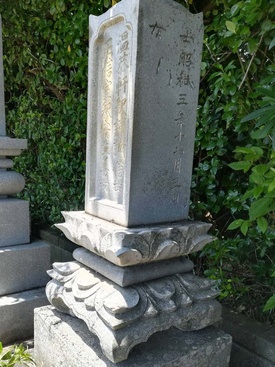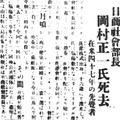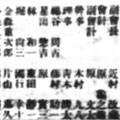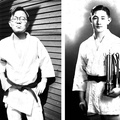In Part 9, I wrote about the Japanese Association that provided support for Yoemon and the days leading up to the opening of his hotel. In this part, I will write about how Yoemon came to his unfortunate end.
An unforeseen accident
It was Sunday morning, December 2, 1928. Yoemon left his home in New Central Hotel (map lower right) for a walk and to go and inspect his hotel in Occidental Street (map left). There were still a number of things to see in preparation for the hotel opening the next day. Around that time, Yoemon had been sleeping late every night and was feeling a bit tired. With his dream of opening a hotel right in front of his eyes, however, the excitement made Yoemon forget all about his fatigue.
When Yoemon arrived at the hotel, he could smell the wall’s fresh coat of paint. He slowly went up the stairs and entered a room on the second floor to inspect it. He found a window that had problems opening and closing. It was during this moment, when Yoemon was climbing up to the window to fix it, that he met with an unexpected accident.
Yoemon suddenly felt dizzy and lost his footing. He fell from the second floor to the street below. The fall broke his leg, and Yoemon lost consciousness. Given that it was a Sunday, the street that Yoemon fell onto was deserted with barely any people around. For a while, no one noticed his body lying there.
The first person to find Yoemon was a young American man who happened to walk by. “There’s a collapsed Japanese,” the man said on a call to the police. The police rushed over and carried Yoemon to the nearby emergency hospital in the city of Seattle. From the documents that Yoemon was carrying with him, they were able to identify his home address and contacted Aki immediately. It was at around 2 p.m when Aki was informed. Aki thought that this must be a mistake for a moment. Upon seeing Yoemon’s personal belongings, however, it became clear that this was no mistake.
By the time Aki had reached the hospital, Yoemon was barely holding on to his consciousness and was beyond saving by the emergency room. He had suffered a cerebral hemorrhage.
At that time, a close friend of Yoemon from Kamai was with Aki. He had driven Aki and Yoemon to the Seattle General Hospital at breakneck speed and arrived in the evening. At the hospital, Yoemon was treated with state-of-the-art medical technology. Aki attended to Yoemon faithfully. Their son, Atae, contacted all of their family and friends from Kamai who were in Seattle, and a large number of them came rushing to the hospital. They stayed up all night in the hospital waiting room, praying for Yoemon’s recovery.
Despite the treatment, Yoemon’s condition did not improve. He passed away the next day, December 3 at 10 a.m. while under Aki’s care. He was 44 years old. Everyone who came rushing to the hospital was extremely shocked at Yoemon’s sudden death and lamented that he would have been saved if only he was brought to this big hospital from the start.
This event was published in the evening edition of the Great Northern Daily News on December 3, 1928. The newspaper had been closely following the progression of Yoemon’s condition. In the morning, when the article was still being written, it was not yet clear whether or not Yoemon would live or die. After learning of Yoemon’s death at 10 a.m., the article was ended with one line, “Passed away.”
FELL FROM THE SECOND FLOOR TO THE STREET
passed away this morning at 10 a.m.
Yoemon Shinmasu was from Yamaguchi Prefecture who was living with his wife and son in New Central Hotel. He had purchased a new hotel located at 311 Occidental Avenue and fell from the window to the street while working on the preparation to open his new hotel. He was seriously injured and was admitted to the city hospital where he received medical treatment. He had a broken leg and suffered interior damage to his body. At present, he is in critical condition. After receiving treatment in the city hospital, Yoemon was brought to the general hospital under the care of his close friend. He is currently under hospitable care, but his survival is still unknown.PASSED AWAY
As noted above — passed away this morning at 10 a.m.
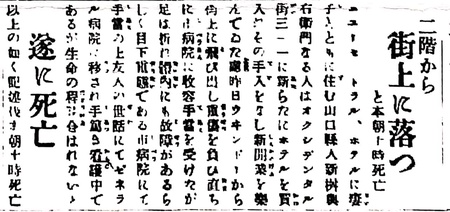
Yoemon’s grand funeral service
The following day (December 4), the Great Northern Daily News published an obituary stating that the funeral service would be held on the 5th from 2 p.m. at the Seattle Buddhist Church. The church was founded in 1901 as the Buddhist Youth Association in Seattle’s Japantown and was renamed the Seattle Buddhist Church in 1926. In 1954, it was elevated to a Jodo Shinshu Buddhist temple and renamed the Seattle Betsuin Buddhist Temple. The temple still exists in Seattle today.
The funeral was filled to the brim with Yoemon’s family, friends, representatives from the Yamaguchi Kenjinkai (Prefectural Association), and members of the barber union. Prominent members of the Seattle community, such as the vice president of the Japanese Association of North America, Hotel Union Chairman Eihan Okiyama, and Sokichi Hoshide from the Japanese Baptist Church of Seattle and accountable person of Yamaguchi Kenjinkai Seiichi Okamura, were also present. It was a gathering of people who could attest to Yoemon’s success in Seattle and showed how admired he was.
From the morning, the day of the funeral was a cold and snowy one with the snow intensifying in the afternoon. It was as if Yoemon was crying from heaven due to his unfortunate end.
Yoemon’s closest friend Chusaburo Ito, president of the Japanese Association of North America, the Yamaguchi Kenjinkai, the barber union, was in Japan at the time of the funeral. Due to the telegraph system, he learned of Yoemon’s death a long time after. Still in the middle of his Japan trip, Ito was dumbfounded and shocked when he learned of Yoemon’s death. He had lost a close brother from his homeland.
The 14-year-old Atae gave a eulogy on behalf of Yoemon’s family at the end of the funeral service. As he had no trouble speaking Japanese, his eulogy was in Japanese. Atae was a bit nervous, however he bore through his grief and gave a magnificent eulogy.
After Yoemon’s death
With the passing of the breadwinner, Aki and Atae were left to themselves in Seattle. Aki had always supported Yoemon with his businesses, however, Yoemon was the one who did all of the crucial work. Although the next few days were chaos for Aki, she found a neatly organized pile of paperwork, including the contracts for the hotel, in the drawer of the desk that Yoemon always used.
With the help of trustworthy family members, friends, the hotel union, and the Yamaguchi Kenjinkai, Aki was able to sell the hotel by the start of the year in January and returned the loan for the hotel to the bank. The hotel that Yoemon had purchased was a sturdy building and was in a good location, so finding a buyer was easier than Aki had expected. After the sale of the hotel had finished, Aki and Atae went to the Seattle public school that Atae was attending and submitted a withdrawal notice. This withdrawal notice was detailed in Part 6.
Atae said his goodbyes to his friends. It had been a year since he transferred to the school and he had made many friends there, so it was very difficult for him to leave them. His sadness was only compounded by the fact that he was going back to Japan, so the chances of them meeting again were essentially zero. His best friend made a promise with Atae to send letters. In September 1929, after Atae had returned to Japan, he actually sent Atae a picture of his family alongside an encouraging letter.
Thus, ended Yoemon and his family’s 17 long years in Seattle.
On February 6, 1929, Aki and Atae boarded the Africa Maru and left Seattle for Kamai. A large number of their family and friends came to see them off at the port of Seattle. Aki was holding Yoemon’s ashes with both of her hands. Many people waved goodbye as the ship left the port. As they grew smaller and smaller, Aki was thinking of the barber shop that she had worked so hard to build with Yoemon. She felt that Yoemon was happy because he finally was able to return to Kamai in peace.
The sorrowful return to Kamai
Yoemon’s family in Kamai did not learn of his death for a while and had gathered together to celebrate the New Year at his new house. On New Year’s Day, somebody in the family saw an orange on the household Buddhist altar tumble down onto the tatami mat, an ominous premonition.
The day after, Jinzo received a letter out of the blue from Aki. He warily opened the letter and upon reading the content, fainted from the shock. The letter stated that Yoemon had died in an accident. Jinzo couldn’t believe it and thought that this must be a mistake. Yoemon’s siblings were also overwhelmed with shock upon learning of this news. After hearing about his death, everyone believed that the falling orange from the household altar was Yoemon’s spirit returning to Kamai during the New Year. News of his death spread across Kamai and the whole village was enveloped in grief.
At the end of February 1929, Aki and Atae, carrying Yoemon’s ashes, travelled from Seattle to Kobe. They took a train from Kobe and arrived in Yanai late in the afternoon. From Yanai, they reserved a small boat that took them to Kamai.
Yoemon’s parents, Jinzo and Sae, his siblings, as well as villagers from Kamai waited impatiently into the dead of night for the arrival of the small boat. When they spotted the light shining from the small boat off the cape, everyone started to shout, their voices barely containing any sadness. The boat resembled the one that Yoemon had taken when he first left for Hawaii. While holding onto Yoemon’s ashes, Aki and Atae despondently disembarked from the small boat onto the ferry which took them to land. Jinzo and Sae, who had come all the way to the harbor, cried and took turns carrying Yoemon’s ashes while saying, “You’ve come home,” as they brought him back to the house on the beachside road. Yoemon’s ashes entered his magnificent new house. Yoemon’s 12- and 10-year old daughters, upon seeing his ashes, were filled with grief and cried their eyes out in Aki’s arms. The tears of the Kamai villagers were so great it was as though they would cause the sea to overflow.
Yoemon’s grave was built near the beach where he loved to swim as a child and where you could see the view of the sea that he saw when he first left for Seattle. On his grave was inscribed “Renowned Man, December 3, 1928” with his posthumous name.
Reference
Hompa Honganji Seattle Buddhist Church, Seattle Betsuin 75th Anniversary, 1901-1976, November 1951.
Hokubei Nenkan (The North American Almanac), The North American Times, 1928.
*This series is a collaboration between Discover Nikkei and The North American Post, Seattle’s bilingual community newspaper. It is an excerpt from “Studies on Immigrants in Seattle – Thoughts on Yoemon Shinmasu’s Success of Barbershop Business,” the writer’s graduation thesis submitted at the Distance Learning Division at the Nihon University as a history major and has been edited for this publication.
© 2020 Ikuo Shinmasu


